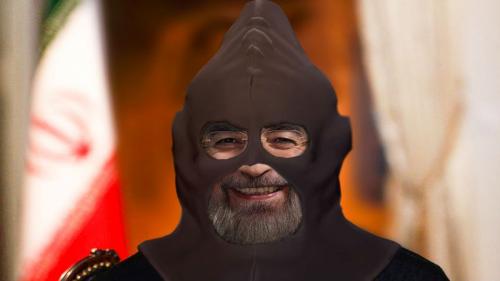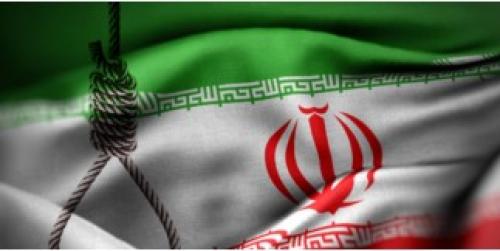22 January 2016 :
Reminder for the Italian AuthoritiesThe election of Hassan Rouhani in June of 2013 was greeted by everyone (almost) as a turnabout and, from that time, the new President of the Islamic Republic was defined as the “reformer”, the “moderate”, the “happy and smiling face” of the Mullah’s regime.
This Report by Hands Off Cain speaks of a different reality, in which the hanging of ethnic and religious minorities and of political opposition for non-violent crimes or those of an essentially political nature, have continued in the in the Islamic Republic led by Hassan Rouhani.
These executions are the latest chapter in a story that began in the summer of 1988 when, following a fatwa issued by Ruhollah Khomeini, more than 30,000 political prisoners, the overwhelming majority of them activists of the People’s Mojahedin Organization of Iran (PMOI/MEK), were hanged for being “enemies of Allah”. While many organizations for the defence of human rights have called it a crime against humanity, many of those responsible for the massacre are now part of the leadership of the regime, including Mostafa Poor Mohammadi and Seyed Ebrahim Reisi – two of the five members of the “Amnesty Commission” that Khomeini had assigned for prisons and that proved to be a “Death Commission” – who have become today, respectively, Minister of Justice and Prosecutor General of the Islamic Republic.
The alarming use of the death penalty, applied to minors in open violation of international accords and conventions ratified by Iran, the discrimination against religious minorities, particularly the Baha’i and Christians, the legal discrimination against women and the persecution of sexual minorities, the destruction of the State of Israel and the negation of the Holocaust, promoted, above all, by the Supreme Guide Khamenei continue to define the Mullah’s Regime regardless of the so-called “moderate” and “smiling” Presidency of Rouhani.
In the name of peace and international security – against the threat of nuclear war and terrorism – Iran regards itself as a “stabilizing force” in the Middle East and beyond, entrusted to an emergency government that created the emergency itself while undermining peace and international security. It would be reasonable that the primary source of the problem become its primary solution. Yet, the most grievous matter here is how a regime has received international legitimacy while internally conducting an ongoing war and daily reign of terror and insecurity against its own people.
What described above should be a reminder for the Italian authorities, who on 25 and 26 January will receive President Hassan Rouhani who chose Rome as the first European capital to visit, identifying Italy as the “front door” towards the West.
We urge the highest representatives of Italy, a country recognized in the world as the champion of the international struggle to promote a universal moratorium on executions, and for the establishment of the International Criminal Court, to put the issue of the death penalty, and more generally of the respect of human rights at the center of every meeting and agreement with representatives of the Islamic Republic of Iran, starting from those with President Rouhani.
At least 2.277 Executions under Rouhani’s Presidency
The election of Hassan Rouhani as President of the Islamic Republic of Iran on 14 June 2013, has led many observers, some human rights defenders and the international community, to be optimistic. However, the new Government has not changed its approach regarding the application of the death penalty, and indeed, the rate of executions has risen sharply since the summer of 2013. Since the beginning of Rouhani’s presidency, as of 15 January 2016, at least 2,277 people have been executed in Iran.
In 2015 the Islamic Republic carried out at least 980 executions, a 22.5% increase compared to 800 in 2014 and a 42.6% increase compared to 687 in 2013. This is the number of executions among the highest in the recent history of Iran, which classifies it as the top “Executioner-Country” in the world in relation to population. At least 370 execution cases (37.7%) were reported by official Iranian sources (websites of the Iranian Judiciary, national Iranian broadcasting network, and official or state-run news agencies and newspapers); 610 cases (62.3%) included in the annual numbers were reported by unofficial sources (other human rights NGOs or sources inside Iran). The actual number of executions is probably much higher than the figures included in the Report of Hands Off Cain.
A majority of those who were executed were convicted of drug-related offences (632 cases, 178 of them reported by official Iranian sources), followed by murder (201 cases, including 122 announced by official sources), rape (56 cases, of which 50 announced by official media), political offences (16 cases, including 5 officially reported), and Moharebeh (waging war against God), armed robbery and “corruption on earth” (22 cases, including 15 officially reported). In at least 53 other cases, the crimes for which the convicts were found guilty remained unspecified.
At least 53 people were executed in the first two weeks of 2016.
Hanging is the preferred method with which to apply Sharia law, but in April 2013 Iran reinserted execution by stoning for those convicted of adultery into a previous version of the new Penal Code that had omitted it.
Public executions by hanging continued into 2015, when at least 58 people were hanged in public.
In 2015, executions of women have slightly decreased: there were at least 15, including a juvenile offender ((8 for drug-related crimes, 2 for murder and 5 for unspecified crimes), but only 2 were announced by Iranian authorities. In 2014, Iran had hanged at least 36 women.
Executions of child offenders continued into 2015, in open violation of two international treaties to which it is party, the International Covenant on Civil and Political Rights (ICCPR) and the Convention on the Rights of the Child (CRC). At least 6 juvenile offenders were hanged in 2015, including one woman (5 for murder cases, including 3 reported by official sources; and 1 for rape, reported by official sources). Another possible minor offender was executed 2016, as of 20 January.
On 17 December 2015, the UN General Assembly adopted a new resolution strongly condemning the brutal and systematic violation of human rights in Iran, in particular the mass and arbitrary executions, increasing violence and discrimination against women and ethnic and religious minorities. The resolution expresses “serious concern at the alarming high frequency of, and increase in the carrying-out of the death penalty, in disregard of internationally recognized safeguards, ... and at the continuing imposition and carrying-out of the death penalty against minors and persons who at the time of their offence were under the age of 18” and calls on the Iranian regime “to abolish, in law and in practice, public executions… and executions carried out in violation of its international obligations” and “to ensure, in law and in practice, that no one is subjected to torture or other cruel, inhuman or degrading treatment or punishment.” The resolution expresses serious concerns about “all forms of discrimination and other human rights violations against women and girls, violence against persons belonging to recognized and unrecognized religious minorities” and calls for the elimination “in law and in practice” of “all forms of discrimination and other human rights violations against persons belonging to ethnic, linguistic or other minorities.” The resolution also calls upon the regime “to end widespread and serious restrictions… on the right to freedom of expression, opinion, association and peaceful assembly” and “to release persons arbitrarily detained.”
Hanging – but not only...
Hanging is often carried out by crane or low platforms to draw out the pain of death. The noose is made from heavy rope or steel wire and is placed around the neck in such a fashion as to crush the larynx causing extreme pain and prolonging the death of the condemned. Hanging is often carried out in public and combined with supplementary punishments such as flogging and the amputation of limbs before the actual execution.
In July 2011, the Japanese crane company Tadano announced that it had ended contracts with the Iranian Government, after United Against Nuclear Iran launched a Cranes Campaign, publishing on its website a list of eight international companies that send crane resources to Iran, with photos of the cranes being used as execution devices. In August 2011, another Japanese crane manufacturer, UNIC, announced the end of its business in Iran, joining Tadano and Terex in pulling out of Iran following UANI’s Cranes Campaign.
In January 2008, then-judicial chief Ayatollah Mahmoud Hashemi Shahroudi decided that public executions, in the future, would be carried out, “only with his approval and based on social necessities.” In fact, public executions decreased in 2008, when there were no less than 30 public hangings, of which 16 took place after Shahroudi’s decree, while no less than 12 people were hanged in public places in 2009, compared to at least 110 people who were publicly executed in 2007. However, since the 2009 post-election protests in Iran, the number of executions, particularly public executions, has risen dramatically.
Executions carried out in public must be added to those more numerous executions, often shrouded in secrecy, carried out in prisons. Most of them were carried out for drug-related offenses.
However, the death penalty is not the only punishment dictated by the Iranian implementation of Sharia. There is also torture, amputation, flogging and other cruel, inhuman and degrading punishments. These are not isolated incidents and they occur in flagrant violation of the International Covenant on Civil and Political Rights that Iran signed and which expressly prohibits such practices. Every year, thousands of youths are whipped for consuming alcohol or attending parties with the opposite sex or for outrages against public decency. Authorities consider whipping an appropriate punishment to combat immorality, and such punishments are publicly inflicted as a “lesson to those who watch.”
On 2 March 2015, a man who was not identified by name was blinded in the left eye in the Rajaee Shahr prison of Karaj as part of “an eye for an eye” punishment for an acid attack, Hamshahri newspaper reported. It is not known whether the blinding was conducted by the medical staff or by the offended. The prisoner was convicted of pouring acid on the face of another man, leading to blindness in both eyes. He was sentenced to: blindness in eyes, payment of “Diyeh” (blood money) and 10 years in prison. Blindness of the right eye was postponed according to the report.
Between 3 and 4 August 2015, two inmates, identified as Rahman K. and Mehdi R., had their right hand and left foot severed by the authorities in a prison in Mashhad. They were accused of committing a bank heist and convicted of Moharebeh. On 28 June, the fundamentalist regime amputated the fingers of two prisoners in the same prison in Mashhad. In May 2015, a high ranking Iranian cleric, who is the representative of the regime’s Supreme Leader in Hormozgan province, had called for more inhumane punishments of hand amputations to be carried out. While visiting Mashhad, Ghulam-Ali Naeem Abadi said: “If the hands of a few of those who commit theft in society are cut off, they would serve as examples for others.” “Security would be restored in society by amputating a few fingers; why then are such punishments not being fully implemented?” he asked.
On 2 November 2015, IRNA state news agency reported that the Iranian regime had ratified an amendment to the misogynic bill dubbed “Protecting sanctity of hijab and morality”. According to this amendment, all women employees have to wear a uniform dress determined by the regime. According to Iranian regime officials, this bill will not only cover governmental agencies but will include private companies and institutions, kindergartens, parks and recreational sites, and businesses. The bill also specifies fines, detention and slashing wages of women employees on the pretext of “mal-veiling”. According to this bill, “women’s occupation in businesses… should observe segregation from men and working hours of 7 am to 10 pm. Failing to observe this article will be considered a violation and the business that has violated the law will be closed down for one week by the security forces and if repeated will be closed for a month.” According to another article of this bill that was adopted in mid August by regime’s parliament, women drivers who fail to observe the medieval laws of hijab imposed by the regime will face heavy fines and their driver’s licenses will be revoked. Moreover, “the driver is responsible for whatever goes on in the car and thus drivers are accountable for the way their passengers are dressed”. As such, even the driver of the vehicle should pay a fine for the “mal-veiling” of the passengers.
Stoning
In April 2013, the Guardian Council, an unelected body of 12 religious jurists empowered to vet all legislation to ensure its compatibility with Iran’s Constitution and Sharia, reinserted the stoning provision into a previous version of the new Penal Code, which had omitted stoning to death as the explicit penalty for adultery. The draft Penal Code, as amended by the Guardian Council, explicitly identifies stoning as a form of punishment for people convicted of adultery or sex outside of marriage. Under Article 132, paragraph 3, a man or a woman can be stoned to death for multiple extramarital affairs. In addition, under article 225, if a court and the head of the judiciary rule that it is “not possible” in a particular case to carry out the stoning, the person may be executed by another method if the authorities proved the crime on the basis of the eyewitness testimony or the defendant’s confession. The revised code also provides that courts that convict defendants of adultery based on the “knowledge of the judge,” a notoriously vague and subjective doctrine allowing conviction in the absence of any hard evidence, may impose corporal punishment sentences of 100 lashes rather than execution by stoning. The penalty for people convicted of fornication, or sex outside of marriage that involves an unmarried person, is 100 lashes.
Iran had the world’s highest rate of execution by stoning, but no one knows with certainty how many people have been stoned in Iran. According to a list compiled by the Human Rights Commission of the National Council of the Iranian Resistance, at least 150 people have been stoned in Iran since 1980. The reported numbers are probably lower than the actual numbers, because most of the condemnations to stoning issued by the Iranian authorities are handed down secretly, as well as for the fact that so little information is actually available from many prisons in Iran. Shadi Sadr, who has represented five people sentenced to stoning, said Iran carried out stoning in secret in prisons, in the desert or very early in the morning in cemeteries.
From 2006 to 2009, stoning was carried out at least once a year for a total of at least seven executions; the last was carried out on 5 March 2009 on a man condemned of adultery. Currently, at least 11 people are in prison under sentence of stoning, according to lawyer Shadi Sadr. Some of these cases were still under review and different sentences could still be issued.
Blood Money
Iranian law provides that the “blood money” (Diya) for a woman is half that of a man. Furthermore, if a man kills a woman, a man cannot be executed, even if condemned to death, without the family of the woman first paying to the family of the murderer half the price of his blood money.
On 27 December 2003, after a favourable verdict issued by supreme leader Ayatollah Ali Khomeini, a law went into effect launched by Parliament in January that guaranteed non-Muslim minorities the right to the same “blood money” as Muslims, which currently corresponds to 442 million riyal (about 36,000 USD). The blood money for the life of a woman continues, however, to be one half of that of a man.
Iranian authorities claimed that “We can’t deny a victim’s family of the legal right to ask for Islamic Qisas, or eye for eye retribution.” Qisas is probably the only “right” of the Iranian people that the regime insists on protecting.
However, the Iranian Penal Code exempts, among others, the following people from Qisas: Muslims, followers of recognized religions, and “protected persons” who kill followers of unrecognized religions or “non-protected persons” (Article 310). This concerns, in particular, members of the Bahai faith, which is not recognized as a religion, according to Iranian law. If a Bahai follower is murdered, the family does not receive blood money, and the offender is exempted from Qisas.
Death Penalty for Blasphemy and Apostasy
In Iran, apostasy and blasphemy are both outlawed and punishable by death. It is illegal for Muslims to convert to Christianity, although Christians are allowed to convert to Islam.
The approval of the new Islamic Penal Code (IPC) in 2013 might lead to more death penalties for apostasy. Apostasy is not explicitly mentioned in the new IPC. However, the new law makes it easier for judges to issue the death penalty for apostasy because Article 220 of the new Code states: “If the present law is silent about any of the Hudud cases, the judge is referred to article 167 of the Constitution.” Article 167 of Iran’s Constitution explains: “The Judge is bound to attempt to rule on each case, on the basis of the codified law. In case of the absence of any such law, he has to deliver his judgment on the basis of official Islamic sources and authentic fatwa. He, on the pretext of the silence of or deficiency of the law in the matter, or its brevity or contradictory nature, cannot refrain from admitting and examining cases and delivering his judgment.” The reference to article 167 was previously made in the Civil Code but now it is also included in the Penal Law.
On 20 June 2015, a 23-year-old former nuclear physics student, Hesameddin Farzizadeh, was sentenced to death for apostasy by the Criminal Court of Meshkinshahr in Ardebil province, reported the Iran Human Rights Documentation Center (IHRDC). He was arrested in a raid on his house in November 2014 by plainclothes Ministry of Intelligence (MOI) agents and held incommunicado at the MOI facility in the town for several days before being transferred to Meshkinshahr Prison. The charge of apostasy stems from a book written by Farzizadeh, entitled “From Islam to Islam”, in which Farzizadeh examines the history of Shi’a Islam and raises questions about certain facets of Shi’a ideology. For instance, in his book Farzizadeh reportedly questions the existence of the Twelfth Imam, who, according to Shi’a theology, is a messianic figure who is to eventually reappear as a latter-day saviour of humanity. In addition to his death sentence, Farzizadeh was also sentenced to seven years of imprisonment and 74 lashes. These sentences rise from charges of insulting the Prophet Mohammad, the Shi’a Imams, and Ayatollah Khomeini. Farzizadeh’s sentence does not only violate basic international human rights norms. The ruling from the Criminal Court of Meshkinshahr appears to violate Iran’s domestic criminal procedure laws, as well. Under Article 4 of the Law to Establish Public and Revolutionary Courts, only Provincial Criminal Courts have the jurisdiction to hear capital cases such as apostasy, whereas the Meshkinshahr Criminal Court is a county-level judicial body.
Death Penalty for Juvenile Offenders
The execution of people for crimes committed before 18 years of age is a breach of the International Covenant on Civil and Political Rights (ICCPR) and the Convention on the Rights of the Child (CRC).
Under Iranian law, girls above nine years of age and boys over 15 are considered adults, and therefore can be condemned to death. Authorities generally wait for young convicts to reach their eighteenth birthday before ordering their execution.
Following requests – ignored for years – to stay death sentences handed down for all convicts accused of committing crimes as minors, the Mullah’s regime announced a partial and, in reality, insignificant revision of the Iranian norm, once again, out of step with the international community.
In fact, article 90 of the new Penal Code stipulates that legally “mature” individuals under eighteen (i.e., boys between the ages of fifteen and eighteen and girls between the ages of nine and eighteen) who are convicted of Hudud and Qisas crimes may be exempt from adult sentences – including the death penalty – only if it is established that they were not mentally mature and developed at the time of committing the crime, and could not recognize and appreciate the nature and consequences of their actions. Therefore, this article gives judges the discretion to decide whether a child has understood the nature of the crime and therefore whether he or she can be sentenced to death.
In 2014, there were at least 17 executions of people under the age of 18 at the time of their crime, and they were carried out in only one country, Iran. Executions of child offenders continued into 2015, when at least 6 people were hanged in 2015, including one woman. Another possible minor offender was executed 2016, as of 20 January.
On 19 February 2015, Kurdish political prisoner Saman Naseem, who was sentenced to death for offences he allegedly committed at 17 years of age, was executed in the prison of Orumieh along with two other political prisoners.
On 15 April 2015, five murder convicts were hanged in the Rajaee Shahr prison of Karaj, State-run Jam-e Jam daily reported. According to Iran Human Rights, one of the prisoners, identified as Javad Saberi, was reportedly sentenced to death for a murder he had committed when he was less than 18 years of age. Javad Saberi had a serious mental illness and had stayed at “Amin Abad” mental hospital, according to these sources.
On 6 October 2015, a juvenile offender, Samad Zahabi, was secretly hanged for a murder he allegedly committed at 17. He was hanged in Kermanshah’s Dizel Abad Prison for shooting a fellow shepherd during a row over who should graze their sheep. This execution was also carried out without a 48 hour notice period being given to Zahabi's lawyer, as is required by law. Horrifically his family said they only learned of his fate after his mother visited the prison on 5 October 2015.
On 13 October 2015, a 23-year-old woman, Fatemeh Salbehi, was hanged in the Adelabad prison of Shiraz for a crime she allegedly committed when she was 17, reported the Mizan Online News Agency. Fatemeh was convicted of murdering her 30-year-old husband, Hamed Sadeghi, whom she had been forced to marry at the age of 16 in 2008. She married Hamed Sadeghi at the age of 16. She didn't have access to lawyer at the time of interrogations. She had been sentenced to death in May 2010 and her death sentence was upheld by Iran’s Supreme Court later that year. The adoption of a new Islamic Penal Code in May 2013 sparked hopes that Fatemeh Salbehi and other juvenile offenders on death row may have their death sentences quashed and their cases re-examined. Article 91 of the Code allows judges to replace the death penalty with an alternative punishment if they determine that the juvenile offender did not comprehend the nature of the crime or its consequences or his or her “mental growth and maturity” are in doubt. The re-examination hearing that Fatemeh Salbehi was granted in relation to Article 91 proved to be deeply flawed. It lasted only three hours and focused mostly on whether she prayed, studied religious textbooks at school and understood that killing another human being was “religiously forbidden.” On this basis, the Provincial Criminal Court of Fars Province had ruled in May 2014 that she had the maturity of an adult and therefore deserved the death sentence.
On 24 November 2015, an 18-year-old prisoner was executed at the Rajaeeshahr Prison in Karaj for murder, reported semi-official Hamshahri Online. He was identified by the Human Rights Activists News Agency (HRANA) as Mohammad Baygi, who reportedly committed his alleged crime at the age of 11. He was arrested at the age of 16 and executed at the age of 18.
On 14 December 2015, a 20-year-old prisoner was hanged in public in Noshahr on murder charges, reported state run IRNA. Milad Khodavardi was arrested in 2013 for allegedly murdering a woman, Mehri Mallamiri. According to a Iran Human Rights’ source Khodavardi was under the age of 18 at the time of the crime.
On 13 January 2016, a prisoner, identified as Houshang Zare, was hanged at Shiraz's Adelabad Prison on murder charges, reported the Human Rights Activists News Agency (HRANA). A close source who asked to be anonymous told Iran Human Rights that Zare was under the age of 18 when he allegedly committed the murder for which Iranian courts sentenced him to death.
The “War on Drugs”
The International Covenant on Civil and Political Rights (ICCPR) grants an exception to the right to life to countries that have not yet abolished the death penalty, but only in relation to the ‘most serious crimes’. The jurisprudence has developed to the point where UN human rights bodies have declared that drug offences are not among the ‘most serious crimes’. The ‘most serious crimes’ threshold for the lawful application of capital punishment is also supported by UN political bodies, which clarified that by ‘most serious crimes’ it is intended only those ‘with lethal or other extremely grave consequences’. Therefore, executions for drug offences violate international human rights law.
Iranian law provides for the death penalty in cases of possession of more than 30 grams of heroin or 5 kilos of opium.
In Iran drug-related offences are tried in Revolutionary Courts, which routinely fall far short of international fair trial standards. Revolutionary Court trials are frequently held behind closed doors and judges have the discretion to restrict lawyers’ access to the defendant during pre-trial investigations in limited cases. Under Article 32, death row prisoners convicted on drug-related offences do not have the right to appeal. Only the Attorney General or the head of the Supreme Court can appeal the death sentence for such convictions.
Since the vast majority of those executed for drug-related charges are not identified by last (family) name, it is not possible to confirm the charges. Human rights observers believe that many of those executed for common crimes such as drugs are actually political dissidents.
The prohibitionist ideology concerning drugs once again made its contribution to the practice of the death penalty in Iran. Of the at least 980 executions tallied by Hands Off Cain in 2015, at least 632 (64.57%) were for drug-related offenses, including 178 announced by official Iranian sources.
On 13 November 2015, in a rare public comment on the death penalty since he took office in June 2013, President Hassan Rouhani claimed Iran has hanged hundreds of drug offenders to prevent drug trafficking into Europe. In an interview yesterday with the Italian newspaper Corriere della Sera, Rouhani noted that “most executions refer to illicit drugs trafficking”, and warned that “if we abolished the death penalty we would enhance their drug trafficking up to the European countries and that would be dangerous for you”.
In open contradiction to their policy for the abolition of the death penalty in the world, European Governments, such as France and Germany, have historically been the main donors to UN drug programmes in Iran. Contributions were withdrawn by Denmark, Ireland, and the United Kingdom over concerns around Iran’s execution rate. The UK decided to halt its financing to anti-drug fund destined to Iran, but not to that for Pakistan, where the it has given more than £12 million to support anti-drug operations.
The United Nations’ Office on Drugs and Crime (UNODC)’s own human rights policy stipulates that “If, following requests for guarantees and high-level political intervention, executions for drug related offences continue, UNODC may have no choice but to employ a temporary freeze or withdrawal of support”. Despite the agency’s own evaluation of its most recent Iranian funding programme found that “no action has been taken yet in line with UNODC guidance”, on 21 December 2015, the UN announced a new $20 million funding deal for anti-drug operations in Iran, despite drug related executions reaching a 16 year high. The UN’s new funding deal will more than double UN funding for Iranian counter-narcotics efforts, and will be administered by the UNODC. The money is expected to support a range of law enforcement operations, including the establishment of border posts designed to catch drug mules crossing the country’s border with Afghanistan.
The “War on Terror”
In 2015, Iran executed at least 16 people on charges of terrorism or for political motives and dissent. Another 22 people were executed for crimes such as Moharebeh (enmity against God), “corruption on earth” or robbery.
Accused of “enmity against God” (Moharebeh) and “corruption on earth” (ifsad fil-arz), those arrested are often subject to rapid and severe trials that often end with a sentence of death. The punishment for Moharebeh is death or amputation of the right hand and left foot, according to the Iranian Penal Code.
However, among those condemned to death or executed for Moharebeh and/or “corruption on earth”, several people were not directly involved in acts of violence. Some of them were political dissidents, members of banned groups or members of Iran’s ethnic and religious minorities, including Iranian Azerbaijanis, Kurds, Baluchis, and Arabs.
The Province of Khuzestan, where ethnic Arabs adhering to Sunni Islam make up the majority of the population, was theatre to harsh repression in 2007. Bombing attacks were even reported in the city of Ahwaz in the Province of Khuzestan in 2005, apparently in response to rumours of a Government plan to reduce the number of ethnic Ahwazi Arabs in the Province. Contrary to Tehran’s propaganda, most Arab movements in al-Ahwaz are not violent separatists. They primarily want an end to discrimination, cultural rights, social justice and regional self-government – not independence.
On 4 March 2015, six Sunni political prisoners were hanged in the prison of Rajaee Shahr in Karaj despite international calls to spare their lives. Hamed Ahmadi, Jahangrir and Jamshid Dehghani (two brothers), Kamal Mowlaie, Seddiq Mohammadi, and Hadi Hosseini were sentenced to death on the charge of Moharebeh, acting against national security and propaganda against the regime in 2009. Reportedly, they were falsely accused of murdering a senior Sunni cleric with links to the Iranian authorities, after being severely tortured for months in Islamic Republic facilities. However, their activities were reportedly linked to cultural-religious affairs such as preaching in public places such as mosques and universities, participating in religious (Sunni) meeting, distributing religious books and CDs, funding religious ceremonies and training of seminarian courses.
The Province of Sistan-Balochistan has also been the centre of heated repression towards Balochi dissidents, adherents of Sunni Islam. On 14 February 2015, two Baloch prisoners, identified as Hamed Kahrazhi and Mobasher Mir-Balochzehi, were hanged in the prison of Chabahar after spending four years in prison for Moharebeh. On 19 December 2015, Abdolghani Gangouzehi Rigi, a 29-year-old man from Baluchistan who was jailed on political charges including Moharebeh, was hanged at Zahedan Central Prison.
Also in Iranian Kurdistan, death sentences and executions have been the response to political dissenters accused of “actions against National security” and “contact with subversive organisations” such as the Party of Free Life of Kurdistan (PJAK), the Kurdistan Democratic Party of Iran (KDPI) and Komalah party, which claim more economic, democratic and cultural rights for Kurds in Iran. On 19 February 2015, Kurdish political prisoner Saman Naseem, who was sentenced to death for offences he allegedly committed at 17 years of age, was executed in the prison of Orumieh along with two other political prisoners. He was sentenced to death in April 2013 by a criminal court in Mahabad for “enmity against God” and “corruption on earth” because of his membership in the Kurdish armed opposition group Party of Free Life of Kurdistan (PJAK), and for taking part in armed activities against the Revolutionary Guards. On 6 June 2015, a well-known Kurdish political prisoner was executed in Miandoab’s Prison. Mansour Arvand, a 39-year-old former wrestler from Mahabad, had been sentenced in 2012 for “Moharebeh” (enmity with God) and “propaganda against the system and membership of Kurdish Democratic Party.” On 9 August 2015, a Kurdish political prisoner, Sirvan Nejavi, was hanged in the central prison of Tabriz. He was arrested in July 2011 in the city of Karaj and was charged with Moharebeh for membership in the Party of Free Life of Kurdistan (PJAK), a Kurdish group that opposes the Iranian regime. On 26 August 2015, Behrouz Alkhani, a 30-year-old man from Iran’s Kurdish minority, was executed at the central prison in Orumieh, despite the fact that he was still waiting for the outcome of a Supreme Court appeal against his sentence. Alkhani was first arrested in January of 2010 and held for more than a year without access to either his family or a lawyer. He was convicted by a Revolutionary Court of collaborating with the PJAK and “enmity against God.”
Persecution of Adherents to Religious and Spiritual Movements
The Constitution states that Ja’afari (Twelver) Shia Islam is the official State religion. It provides that “other Islamic denominations are to be accorded full respect” and officially recognises only three non-Islamic religious groups, Zoroastrians, Christians, and Jews, as religious minorities.
Although the Constitution protects the rights of members of these three religions to practice freely, the Government imposed legal restrictions on proselytising. Seeking to convert Muslims to Christianity or other religions is considered a crime. Converts to Christianity from Islam are often harassed and persecuted and forced to gather in home churches, while Christian missionaries are routinely expelled and sometimes jailed for distributing Bibles and other religious material.
Repression of nearly all non-Shia religious groups – most notably of Baha’is, as well as of Sufi Muslims, evangelical Christians, Jews, and Shia groups not sharing the Government’s official religious views – increased significantly in the past few years. Bahai and Christian groups reported arbitrary arrests, prolonged detentions, and confiscation of property.
The Government considers Baha’is to be apostates and defines the Bahai Faith as a “political sect.” The Government prohibits Baha’is from teaching and practicing their faith and subjects them to many forms of discrimination not faced by members of other religious groups. Since the 1979 Islamic Revolution, the Government has executed more than 200 Baha’is, although there were no reports of Bahai executions during 2015.
Top Secret Death
In Iran, that carries out executions regularly without classifying the death penalty as a State secret, authorities do not release statistics on the implementation of death sentences, the names of the hundreds of convicts executed each year, or the crimes for which they were found guilty.
The Iranian system and its treatment of information regarding the death penalty became even more opaque when, on 14 September 2008, the Mullahs’ Ministry of Culture and Islamic Guidance (MCIG) warned newspaper editors to censor reports about escalating numbers of executions, in particular those of minors in the country.
In 2015 the Islamic Republic carried out at least 980 executions. At least 370 execution cases (37.7%) were reported by official Iranian sources (websites of the Iranian Judiciary, national Iranian broadcasting network, and official or state-run news agencies and newspapers); 610 cases (62.3%) included in the annual numbers were reported by unofficial sources (other human rights NGOs or sources inside Iran). The actual number of executions is probably much higher than the figures included in the Report of Hands Off Cain.
According to statistics compiled by the Abdorrahman Boroumand Foundation (AFB), in 2015, Iran executed 1.084 people, which marks the highest rate of executions in the country in 25 years. These statistics are drawn from ABF’s daily surveys of more than 50 newspapers, websites, and blogs. A large number of those executed are from religious minority groups, such as Christian converts, Bahá’í adherents, Sunni Muslims, and Kurds.
(Sources: Hands Off Cain)







